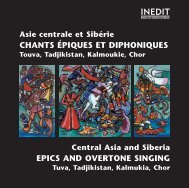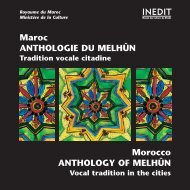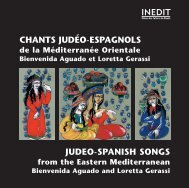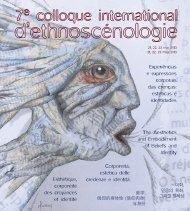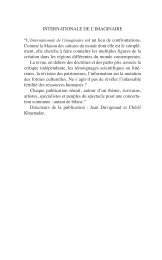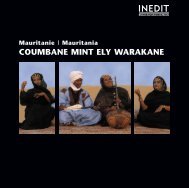le pavillon aux pivoines - Maison des Cultures du Monde
le pavillon aux pivoines - Maison des Cultures du Monde
le pavillon aux pivoines - Maison des Cultures du Monde
Create successful ePaper yourself
Turn your PDF publications into a flip-book with our unique Google optimized e-Paper software.
Chinese opera distinguishes two ways of training<br />
the voice that apply to dialogues and<br />
recitatives as well as to singing. The falsetto<br />
voice is reserved for fema<strong>le</strong> characters both<br />
young and <strong>le</strong>ss young – a hangover no doubt<br />
from the time, not so long ago, when such<br />
ro<strong>le</strong>s were played by men – and for young<br />
men (personified here by the actress Kao Huilan).<br />
For these latter, the exercise is particularly<br />
difficult since the actor must render the<br />
cracked voice of an ado<strong>le</strong>scent whose voice is<br />
breaking. The natural voice is used in ma<strong>le</strong><br />
ro<strong>le</strong>s and for old women.<br />
Four essential princip<strong>le</strong>s regulate declamation<br />
or prose recitation and good performance in<br />
kunqu singing.<br />
1. The “five sounds”, coming from the<br />
throat, the tongue, the molars, the incisors<br />
and the lips.<br />
2. The “four respirations” : with the mouth<br />
wide open, the sound comes out freely; in closing<br />
the teeth, the sound begins to whist<strong>le</strong>; in<br />
pursing the lips, the sound slips between<br />
them; the well-rounded mouth means that the<br />
sound comes up from the depths of the throat.<br />
3. Respect for the four tones of the tonal system<br />
of the Chinese language.<br />
4. Articulating words, on the one hand,<br />
breaking them down into three sounds: the<br />
head, the belly and the tail, on the other<br />
hand, c<strong>le</strong>ar distinction of the following word<br />
so as to avoid any confusion.<br />
Declamation is in three orders, declamation<br />
in prose used for monologues, dialogue in<br />
–26–<br />
ordinary language and finally, poetry in regular<br />
verse which the poet uses to comment on<br />
the action (sung here by the chorus).<br />
Kunqu uses seven musical mo<strong>des</strong> which correspond<br />
to the various transpositions (or<br />
‘aspects’) of the pentatonic sca<strong>le</strong> augmented by<br />
its two <strong>aux</strong>iliary degrees [(C, D, E (F), G, A, (B)],<br />
and in which each of the degrees acts as tonic<br />
to one of the seven mo<strong>des</strong>. Each of these<br />
mo<strong>des</strong> has its corresponding expression for<br />
various sentiments (melancholy, joy, torment,<br />
anxiety, anger...) which are classified according<br />
to a definite system, the kong tiao; finally,<br />
the tunes or qupai on which the songs are performed<br />
are regrouped according to each kong<br />
and each tiao. As we have seen, there were 335<br />
different airs in yuanqu and 543 in nanqu.<br />
There are more than a thousand in kunqu,<br />
derived from repertories in both the North<br />
and South, and it is up to the author of the<br />
piece to choose the qupai that best translates<br />
the feelings of the character who is singing.<br />
This way of composing explains why the work<br />
remains above all that of a poet and not a<br />
musician, with the exception of course of Wei<br />
Liangfu who was the creator of the genre.<br />
The orchestra may be divided into three<br />
groups of instruments; percussion, wind and<br />
string.<br />
Percussion instruments play an all-important<br />
ro<strong>le</strong>. They keep time, punctuate the voice and<br />
gestures of the actors by marking strong emotions<br />
such as anxiety, suffering, fits of rage,<br />
and provide sound effects. There is the flat



